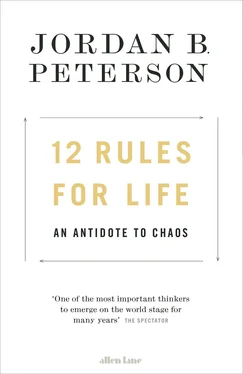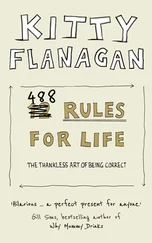You truly know you are the Son of God when your dicta apply even to crustaceans.
Back to the fractious shellfish: it doesn’t take that long before lobsters, testing each other out, learn who can be messed with and who should be given a wide berth—and once they have learned, the resultant hierarchy is exceedingly stable. All a victor needs to do, once he has won, is to wiggle his antennae in a threatening manner, and a previous opponent will vanish in a puff of sand before him. A weaker lobster will quit trying, accept his lowly status, and keep his legs attached to his body. The top lobster, by contrast—occupying the best shelter, getting some good rest, finishing a good meal—parades his dominance around his territory, rousting subordinate lobsters from their shelters at night, just to remind them who’s their daddy.
The female lobsters (who also fight hard for territory during the explicitly maternal stages of their existence [18014] As theorized by Wolff, J.O. & Peterson, J.A. (1998). “An offspring-defense hypothesis for territoriality in female mammals.” Ethology, Ecology & Evolution, 10 , 227-239; Generalized to crustaceans by Figler, M.H., Blank, G.S. & Peek, H.V.S (2001). “Maternal territoriality as an offspring defense strategy in red swamp crayfish ( Procambarus clarkii, Girard ).” Aggressive Behavior, 27 , 391-403.
) identify the top guy quickly, and become irresistibly attracted to him. This is brilliant strategy, in my estimation. It’s also one used by females of many different species, including humans. Instead of undertaking the computationally difficult task of identifying the best man, the females outsource the problem to the machine-like calculations of the dominance hierarchy. They let the males fight it out and peel their paramours from the top. This is very much what happens with stock-market pricing, where the value of any particular enterprise is determined through the competition of all.
When the females are ready to shed their shells and soften up a bit, they become interested in mating. They start hanging around the dominant lobster’s pad, spraying attractive scents and aphrodisiacs towards him, trying to seduce him. His aggression has made him successful, so he’s likely to react in a dominant, irritable manner. Furthermore, he’s large, healthy and powerful. It’s no easy task to switch his attention from fighting to mating. (If properly charmed, however, he will change his behaviour towards the female. This is the lobster equivalent of Fifty Shades of Grey , the fastest-selling paperback of all time, and the eternal Beauty-and-the-Beast plot of archetypal romance. This is the pattern of behaviour continually represented in the sexually explicit literary fantasies that are as popular among women as provocative images of naked women are among men.)
It should be pointed out, however, that sheer physical power is an unstable basis on which to found lasting dominance, as the Dutch primatologist Frans de Waal [18015] Waal, F. B. M. de (2007). Chimpanzee politics: Power and sex among apes . Baltimore, MD: Johns Hopkins University Press; Waal, F. B. M. de (1996). Good natured: The origins of right and wrong in humans and other animals. Cambridge, MA: Harvard University Press.
has taken pains to demonstrate. Among the chimp troupes he studied, males who were successful in the longer term had to buttress their physical prowess with more sophisticated attributes. Even the most brutal chimp despot can be taken down, after all, by two opponents, each three-quarters as mean. In consequence, males who stay on top longer are those who form reciprocal coalitions with their lower-status compatriots, and who pay careful attention to the troupe’s females and their infants. The political ploy of baby-kissing is literally millions of years old. But lobsters are still comparatively primitive, so the bare plot elements of Beast and Beauty suffice for them.
Once the Beast has been successfully charmed, the successful female (lobster) will disrobe, shedding her shell, making herself dangerously soft, vulnerable, and ready to mate. At the right moment, the male, now converted into a careful lover, deposits a packet of sperm into the appropriate receptacle. Afterward, the female hangs around, and hardens up for a couple of weeks (another phenomenon not entirely unknown among human beings). At her leisure, she returns to her own domicile, laden with fertilized eggs. At this point another female will attempt the same thing—and so on. The dominant male, with his upright and confident posture, not only gets the prime real estate and easiest access to the best hunting grounds. He also gets all the girls. It is exponentially more worthwhile to be successful, if you are a lobster, and male.
Why is all this relevant? For an amazing number of reasons, apart from those that are comically obvious. First, we know that lobsters have been around, in one form or another, for more than 350 million years. [18016] Bracken-Grissom, H. D., Ahyong, S. T., Wilkinson, R. D., Feldmann, R. M., Schweitzer, C. E., Breinholt, J. W., Crandall, K. A. (2014). “The emergence of lobsters: Phylogenetic relationships, morphological evolution and divergence time comparisons of an ancient group.” Systematic Biology, 63 , 457–479.
This is a very long time. Sixty-five million years ago, there were still dinosaurs. That is the unimaginably distant past to us. To the lobsters, however, dinosaurs were the nouveau riche , who appeared and disappeared in the flow of near-eternal time. This means that dominance hierarchies have been an essentially permanent feature of the environment to which all complex life has adapted. A third of a billion years ago, brains and nervous systems were comparatively simple. Nonetheless, they already had the structure and neurochemistry necessary to process information about status and society. The importance of this fact can hardly be overstated.
It is a truism of biology that evolution is conservative. When something evolves, it must build upon what nature has already produced. New features may be added, and old features may undergo some alteration, but most things remain the same. It is for this reason that the wings of bats, the hands of human beings, and the fins of whales look astonishingly alike in their skeletal form. They even have the same number of bones. Evolution laid down the cornerstones for basic physiology long ago.
Now evolution works, in large part, through variation and natural selection. Variation exists for many reasons, including gene-shuffling (to put it simply) and random mutation. Individuals vary within a species for such reasons. Nature chooses from among them, across time. That theory, as stated, appears to account for the continual alteration of life-forms over the eons. But there’s an additional question lurking under the surface: what exactly is the “nature” in “natural selection”? What exactly is “the environment” to which animals adapt? We make many assumptions about nature—about the environment—and these have consequences. Mark Twain once said, “It’s not what we don’t know that gets us in trouble. It’s what we know for sure that just ain’t so.”
First, it is easy to assume that “nature” is something with a nature—something static. But it’s not: at least not in any simple sense. It’s static and dynamic, at the same time. The environment—the nature that selects—itself transforms. The famous yin and yang symbols of the Taoists capture this beautifully. Being, for the Taoists—reality itself—is composed of two opposing principles, often translated as feminine and masculine, or even more narrowly as female and male. However, yin and yang are more accurately understood as chaos and order. The Taoist symbol is a circle enclosing twin serpents, head to tail. The black serpent, chaos, has a white dot in its head. The white serpent, order, has a black dot in its head. This is because chaos and order are interchangeable, as well as eternally juxtaposed. There is nothing so certain that it cannot vary. Even the sun itself has its cycles of instability. Likewise, there is nothing so mutable that it cannot be fixed. Every revolution produces a new order. Every death is, simultaneously, a metamorphosis.
Читать дальше












